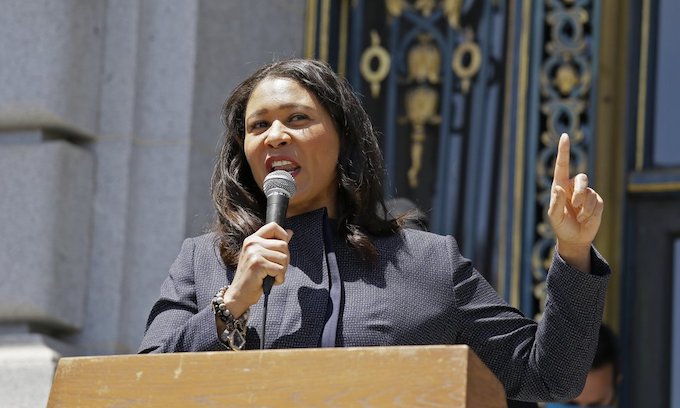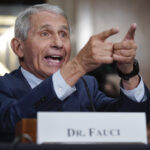At a press conference Tuesday announcing a slate of new public safety policies, Mayor London Breed signaled a fundamental shift in The City’s approach to crime and drug use with unusually strong rhetoric.
“It’s time that the reign of criminals who are destroying our city, it is time for it to come to an end,” Breed said. “And it comes to an end when we take the steps to be more aggressive with law enforcement … and less tolerant of all the bullsh*t that has destroyed our city.”
Breed announced several new policies designed to combat drug dealing, outdoor drug use, shoplifting and the sale of stolen goods. Breed’s plan also calls for new investments in the safety and beautification of the Tenderloin, as well as increases in police funding and staffing.
Breed compared the plan, which will be coordinated by the Department of Emergency Management, to the City’s response to the pandemic, calling it an emergency.
Broadly, the proposal calls for a multi-tiered three-month intervention as well as increased overtime funding for police presence in the Tenderloin. One of the most controversial shifts would be to ramp up enforcement of open-air drug sales and use.
“We are not going to just walk by and let someone use in broad daylight,” Breed said. The new approach would give drug users “a choice between going to the location we have identified for them or going to jail.”
The intensified police presence approach to drugs is a stark contrast to programs like the Street Crisis Response Team, which launched in November 2020 as an alternative to police to respond to mental health and substance use crises on the streets.
The proposal is likely to be met with frustration among those who say increasing police presence will make drug dealing and use more secretive and dangerous, and that many individuals experiencing homelessness already have had negative experiences with police and health care systems.
More than 6,000 overdose deaths have been prevented in San Francisco this year through community-based distribution of naloxone, a medication that reverses opioid overdoses, according to data provided by the DOPE project, a harm reduction nonprofit.
“We are a city that prides ourselves on second chances,” Breed said. But “our compassion should not be confused for weakness or indifference.”
The mayor’s proposal includes a “Tenderloin Emergency Plan” that would implement infrastructural repairs to make the streets safer, like fixing lights and adding more garbage bins and public toilets. It would also set up a temporary resource hub to help connect people with drug use disorders to medical and mental health treatment. It’s unclear how this plan relates to The City’s ongoing efforts to open a safe consumption site for drug use sometime next year.
The mayor also wants to change The City’s surveillance ordinance so SFPD no longer needs Board of Supervisors approval to obtain and use camera technology. In an attempt to curb retail theft, the plan would create an “exclusion zone” for street vending in locations such as United Nations Plaza.
The final phase of the proposal will focus on sustaining these public safety strategies over the long-term and securing ongoing funding for neighborhood beautification, community ambassadors along Market Street and overtime for police.
The call for increased police funding is a notable shift from Breed’s stance in 2020 when she redirected funds from law enforcement to support the African American community.
“There are areas in this city that need constant, 24-hour police presence,” said SFPD Chief William Scott at the press conference. “From the lips of people who play and work in this city to my ears, this is what I’m hearing over and over again.”
Breed acknowledged her proposals are likely to spark controversy, but sounded a note of determination that she wouldn’t be swayed by critics.
“What I’m proposing today, and what I will be proposing in the future, will make a lot of people uncomfortable. And I don’t care,” she said. “We can’t keep doing the same thing and expecting a different result. And every day we let things linger, our residents are suffering.”
Whether Breed’s rhetoric tracks with the scale of San Francisco’s drug and crime problems is a matter of debate. According to the latest San Francisco Police Department data, homicides are up 15% compared to the same period last year, and larceny thefts are up 18%. Burglary and motor vehicle theft are down slightly.
Despite a small decrease from last year, fatal drug overdoses remain at historic highs; 545 between January and October. Following national trends, homicide and other violent crimes in San Francisco are down significantly since the mid-2000s.
Breed hinted at the attention The City has received from the national media for its crime, drug and homelessness problems, saying she hopes to “change the narrative about what people say about San Francisco.”
She also suggested this effort is now her top priority as mayor: “I want each and every person in this city to know this work and what we are going to do to turn around how people feel in San Francisco is the most important thing to me.”
© 2021 San Francisco Examiner. All rights reserved.
—-
This content is published through a licensing agreement with Acquire Media using its NewsEdge technology.



















“It’s time that the reign of criminals who are destroying our city, it is time for it to come to an end,” Breed said. “And it comes to an end when we take the steps to be more aggressive with law enforcement … and less tolerant of all the bull**** that has destroyed our city.”
Not a day too soon.
“She also suggested this effort is now her top priority as mayor: “I want each and every person in this city to know this work and what we are going to do to turn around how people feel in San Francisco is the most important thing to me.”
The words are nice—and they sound good, but you have to back them up with meaningful action. The businesses, no doubt, will be greatly appreciative to see the needed change. I hope the citizenry is, as well.
NOW let’s see if she has the balls, to follow up her words, with ACTUAL ACTION!
“Breed’s stance in 2020 when she redirected funds from law enforcement to support the African American community.”
And what did this get you??
Black males make up about 7% of the U.S. population but every year commit ~56% of all the murders and ~54% of all robberies in the U.S.. 96% of these murders and robberies are drug related.
Illegal drug use is illegal in civilized responsible areas, for a reason.
You can thank an “open boarder” for that!
I wonder, if we somehow were able to get the stats on what races caused the MOST OF THESE smash and grab looting sprees, what the % OF BLACKS THAT Would be doing that!
In other words she is just saying “Hey, the election is over, and Trump is gone, so tone it down before THE PEOPLE get wise to the real source of all the violence and begin to realize that the theft we politicians do to rob them in taxes, inflated energy and everything, and in corrupts laws and bills of socials wealth redistribution is just a reflection of what our party BLM shock troops are doing to our stores and neigborhoods, who might just really wake up and throw us all out of office and into our well-earned jails.” Her city has so many drugs floating about it you wonder if it is really being run by the Mexican Drug Lords?,,,,follow the money, audit her wealth and the same old dirty footprints will appear where the politicians get richer and THE PEOPLE get poorer and turned from free people to social puppet playthings, with crime Breeders like London get to pull all the strings on command,,,,,dance, don’t dance,,,Police,,,don’t police, oops back to policing.
They kept feeding the crocodile, now it has turned on them.
Grab the popcorn and enjoy the show..
PITY a crock is not LITERALLY eating them.
But then again, that may be considered CRUEL and unusual punishment, TO THE CROC for making it EAT these poisonous snake dems!
You made your bed. Now go lay in it. They put you in and try their best to get as many of your kind in because they know most of your kind are HABITUALLY STUPID. And since they want to kill off the population they will kill your kind off first once depopulation starts. You should be hung for your actions by the people instead. Along with a host of other TRAITOR/TYRANTS.
AND with all the looters, joining you, ON THE GALLOWS.
Uhhhhh, hows about just ENFORCING existing law AND actually prosecuting the perps to the fullest extent of said existing law.
Oh, I forgot…That’s HATE speech,
How dare you bring common sense into their feelings…
That’s white supremacy, and male privilege on display.. RHEE!!!
I say this is an election ploy for the elections next year
I guess comedy is alive and well in California. Both mayors of San Francisco and Oakland are crying about out of control crime rate and asking Newsum, cement face Pelosi’s nephew, for help while stupid ugly old cement face hag gets on TV and can’t figure out why it’s happening. LOL!!!!!!
MAYBE had they not ENCOURAGED IT, for so damn long, things wouldn’t BE THIS WAY!
What a classless, clueless knob! No wonder the city is in the toilet!